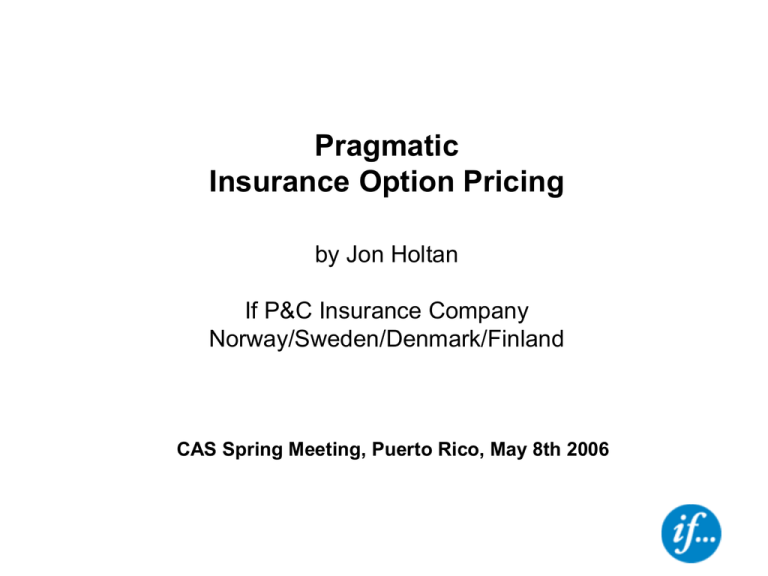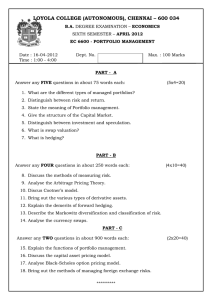Pragmatic Insurance Option Pricing by Jon Holtan If P&C Insurance Company
advertisement

Pragmatic Insurance Option Pricing by Jon Holtan If P&C Insurance Company Norway/Sweden/Denmark/Finland CAS Spring Meeting, Puerto Rico, May 8th 2006 From only fair risk valuation to also include market-oriented pricing Insurance risk/ cost fair valuation Market based insurance pricing Formulated within a Financial market option pricing based context Main objectives of the paper: First of all: Point out a pragmatic market based approach of insurance pricing. Why do different insurance players offer different prices for unique risks in the same market ? Important bi-effect: From a practical point of view describe the common headlines of the theories of insurance and option pricing. Gives valuable pragmatic insight to (stochastic) value versus (market) price relationships ! Well-known: Insurance contract as a call option Call option => C is a Euro call option on stock price S(t) and strike price K Insurance => Z is excess-of-loss contract on claims process N and Y => Z* is stop loss contract on claims process Insurance call contracts => "Insurance option pricing" • Z is a stochastic sum of N single European call options • Z* is an ordinary European call option But: Crucial difference between options and insurances: • Options => based on geometric Brownian stock processes • Insurances => based on compound Poisson claims processes Hard insight: Dynamic hedging of insurance contracts General definitions: • Dynamic hedging => continuously buying and selling • Hedging strategy => remove risk by replicating a risk free payoff Main difference between financial options and insurance: • Options => hedging to remove risk => do not rely on the law of large numbers • Insurance => diversification to manage risk => rely on the law of large numbers However: insurance hedging may be seen as an approach to establish a relevant and efficient insurance market place and hence better understand the market information dynamics. Example: a company reduces its insurance risk through reassurance. The Delbaen & Haezendonck (1989) insurance hedging assumption: An insurer may at any time t sell the remaining claim payments X (T ) X (t ) (t , T ) for some premium p(T t ) . The value of the insurance portfolio at time t = I (t ) X (t ) p (T t ) ; I (0) p(T ) and I (T ) X (T ) . over the period The possibility of selling and buying (= hedging) at any time t implies no arbitrage opportunities (= earn money without taking any risk) in the market. That is: Impossible to earn money by studying the claims history of (0,t) of the insurance portfolio I(t) because all relevant information about the insurance risks are assumed fully reflected into the running risk premium p (T t ) at time t. Hence: The portfolio value process I(t) is a Q-martingale (at each time t the expected next value direction is zero) and hence there should exist a risk neutral probability distribution Q, ref Harrison & Kreps (1979). Key setup: Risk-neutral martingale valuation Help: The arbitrage-free (Black-Scholes) hedging approach helps us to better understand market based insurance pricing. But: Arbitrage-free dynamic hedging of insurance contracts is only possible when buying and selling martingale values. Hence: A risk-adjusted probability measure transformation from P to Q makes a risk-neutral martingale valuation of the insurance contracts Fair value excess of loss: Z (0) EQ e rT Z (T ) Fair value stop loss: Z * (0) EQ* e rT Z * (T ) e rT EQ* X (T ) EQ* D Fair value call option: C (0) EQ** e rT C (T ) = e rT EQ** S (T ) EQ** K What "market" information should we put into Q? Key question: What information should we put into the probability measure Q? 1) Traditional actuarial information approach I: Risk and risk loading Delbaen & Haezendonck (1989) approach: Give more weight to unfavourable events Expected value premium principle => E(X) + a E(X) Variance premium principle => E(X) + b Var(X) Esscher premium principle => E(X exp(aX)) / E(exp(aX)) 2) Traditional actuarial approach II Add expenses, reassurance costs, investment returns => cost allocation 3) Untraditional actuarial information approach => add supply and demand information like purchasing preferences and insurer's price position in the market Very relevant information in incomplete markets ! Actuaries should not let the real market information be irrelevant to them !! Market based insurance pricing Insurance risk valuation OK Formulated within a Financial market option pricing based context Finn & Lane (1997): "There are no right price of insurance.... ...there is simply the transacted market price which is high enough to bring forth sellers and low enough to induce buyers" Key question: Complete or incomplete market? 1) Complete markets => Most financial markets • Unique price per unique risk => Unique market prices => The law of one price • Optimal price per risk is pure risk and cost price based 2) Incomplete markets => Most insurance markets • Optimal price per risk is also market adjusted => Different market prices per risk • Because: Each combination of buyer and seller generates valuable uniqueness ...ref Harrison & Pliska (1983): "A market is complete if and only if there is only one equivalent martingale measure of the underlying stochastic process (stocks or claims) describing the market" Hence: Purchasing preferences should be part of the price models! Key pricing challenge: How to optimize bottom line in markets with profitable and non-profitable segments? Driving elements: • True risk/cost prices versus market prices of different markets/customer segments • Price sensitivity of different markets/customer segments High price Low price Low risk High risk Market based insurance price models A general set up: Net sales price per risk = pure risk price + internal cost allocation price adjustments + external market price adjustments pi (T ) M Ci Z i T I r I I c m A more specific set up => Should be expressed with respect to price p: Net present value V(T) of the insurance portfolio over the time period (0,T): I I T i 1 0 0 V (T ) Vi (T ) e rt pi (t ) Z i (t ) ci (t )Ri (t )dtdi Parameter estimation = real insurance pricing! Risk, expenses, capital & return pricing estimation => Well-known! • Risk selection multi-factor: GLM; Bayesian; Credibility; etc • Price level: RR and CR targets based on capital & return allocation (DFA) per LoB • Claims level trend: ARIMA time series forecasting, Claims reserving, ++ • Expense allocation: Internal "ABC"++ methods (from simple to complex) Market pricing estimation => Not well-known! • Customer purchasing rate (multi-factor based): LogReg on hitrates/renewals • Soft/hard opinions of the price and product positions in the market • Dynamic, flexible, short time-to-market, data driven IT price calculation systems • No final answers and no fixed rules Market based insurance pricing OK Insurance risk valuation OK Formulated within a Financial market option pricing based context Summary insurance versus option pricing Financial call option The value at time t increases… - the longer time to maturity, - the lower the strike price is, - the higher the spot price is*, - the higher the risk free rate is, - the higher the stock volatility is. Practise Theory Insurance contract The value at time t increases… - the longer time to maturity, - the lower the deductible is, - the higher the claims have been*, - the higher the risk free rate is, - the higher the claims risk is. Risk and cost differentiated prices Data driven GLM parameter estimation Incomplete and non-efficient markets Purchasing/price sensitive preferences Data driven market adjusted net prices Still complete and efficient markets Extreme contractual complexity Different contractual objects Computer formula based valuation Implied volatility and market knowledge Insurance claims as underlying risk Implicit complete markets No hedging or arbitrage focus Homo/heterogeneous Poisson processes Risk valuation with safety loadings Stocks/securities as underlying risk Explicit complete and efficient markets Dynamic hedging with no arbitrage Geometric Brownian motion processes Volatility valuation and pricing Insurance Finance




